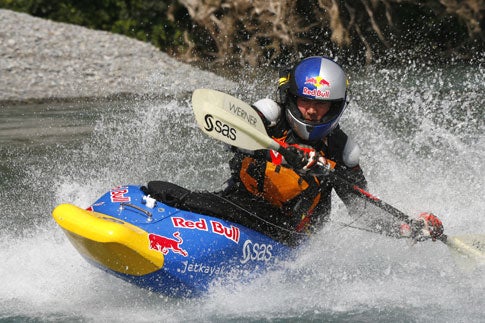The jet kayak
When paddling over waterfalls is no longer a thrill, it's time to add horsepower.

Heading straight for a rock wall along New Zealand’s Waimakariri River Gorge wouldn’t normally faze Shaun Baker. But this was a new experience even for the world-record-holding waterfall jumper—this time his kayak had an engine in it, skipping him like a stone at more than 30 mph. Finally he backed off the throttle just enough to steer himself parallel to the wall and avert disaster, before gunning it back up to full speed.
- Dept: You Built What?!
- Cost: $10,000
- Time: 18 months
A few years ago, Baker grew bored with performing crazy feats in standard kayaks, so he and a few friends decided to change the craft itself by adding some extra power. They picked the only engine that would fit in a 6-foot-long freestyle kayak: a small, flat, 45-horsepower model developed by a company that makes motorized surfboards. Engineer Andy Selway cut a hole in the back of the kayak, built a frame, and rigged the engine to turn a Yamaha jet ski’s pump and impeller, which draw in and expel water. Since the jet-ski parts were designed to handle 75 horses, he machined them down so they would better match the motor.
Once the kayak was complete, Baker worked to learn to control it, which ultimately saved his hide. After his close call in New Zealand, he went on to set a kayak world speed record of 35 mph. Now he’s looking for new adrenaline-drenched challenges. Aerial backflips, anyone?
How it works
Speed
For now, Baker controls velocity with a paddle-mounted finger throttle modified from a quad bike, but he’d like to install a foot-pedal-based system.
Exhaust
Two tubes from an auto-parts supplier are mounted behind Baker’s back to function as engine air intakes. A metal exhaust pipe sits between them, with a spring-loaded cap atop the cylinder to prevent water from getting inside.
Steering
Baker had to learn to use a paddle blade to control his heading at high speeds. If he digs in too deep or leans too far to one side, he’s underwater.
To see what’s under the kayak’s hood, browse the photos below. For footage of the boat in action—specifically, racing a Tomcat 4×4—check out this clip from Top Gear (we’ve long loved these BBC guys and their willingness to put vehicles in, shall we say, unconventional situations.)





This story has been updated. It was originally featured in the July 2007 issue of Popular Science magazine.